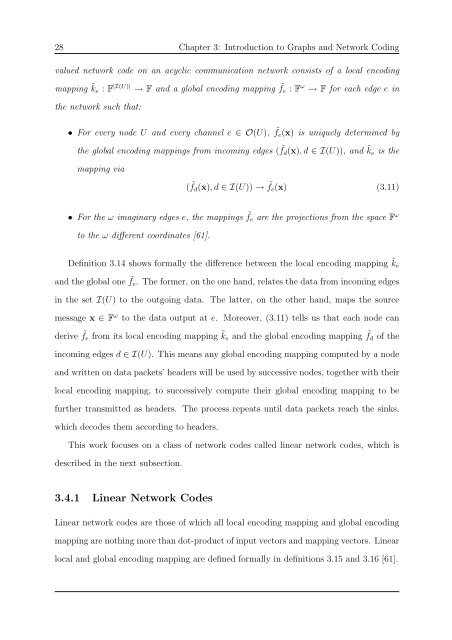Network Coding and Wireless Physical-layer ... - Jacobs University
Network Coding and Wireless Physical-layer ... - Jacobs University
Network Coding and Wireless Physical-layer ... - Jacobs University
You also want an ePaper? Increase the reach of your titles
YUMPU automatically turns print PDFs into web optimized ePapers that Google loves.
28 Chapter 3: Introduction to Graphs <strong>and</strong> <strong>Network</strong> <strong>Coding</strong><br />
valued network code on an acyclic communication network consists of a local encoding<br />
mapping ˜k e : F |I(U)| → F <strong>and</strong> a global encoding mapping ˜f e : F ω → F for each edge e in<br />
the network such that:<br />
• For every node U <strong>and</strong> every channel e ∈ O(U), ˜fe (x) is uniquely determined by<br />
the global encoding mappings from incoming edges ( ˜f d (x), d ∈ I(U)), <strong>and</strong> ˜k e is the<br />
mapping via<br />
( ˜f d (x), d ∈ I(U)) → ˜f e (x) (3.11)<br />
• For the ω imaginary edges e, the mappings ˜f e are the projections from the space F ω<br />
to the ω different coordinates [61].<br />
Definition 3.14 shows formally the difference between the local encoding mapping ˜k e<br />
<strong>and</strong> the global one ˜f e . The former, on the one h<strong>and</strong>, relates the data from incoming edges<br />
in the set I(U) to the outgoing data. The latter, on the other h<strong>and</strong>, maps the source<br />
message x ∈ F ω to the data output at e. Moreover, (3.11) tells us that each node can<br />
derive ˜f e from its local encoding mapping ˜k e <strong>and</strong> the global encoding mapping ˜f d of the<br />
incoming edges d ∈ I(U). This means any global encoding mapping computed by a node<br />
<strong>and</strong> written on data packets’ headers will be used by successive nodes, together with their<br />
local encoding mapping, to successively compute their global encoding mapping to be<br />
further transmitted as headers. The process repeats until data packets reach the sinks,<br />
which decodes them according to headers.<br />
This work focuses on a class of network codes called linear network codes, which is<br />
described in the next subsection.<br />
3.4.1 Linear <strong>Network</strong> Codes<br />
Linear network codes are those of which all local encoding mapping <strong>and</strong> global encoding<br />
mapping are nothing more than dot-product of input vectors <strong>and</strong> mapping vectors. Linear<br />
local <strong>and</strong> global encoding mapping are defined formally in definitions 3.15 <strong>and</strong> 3.16 [61].

















